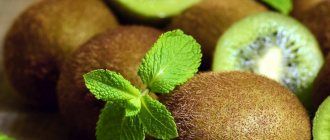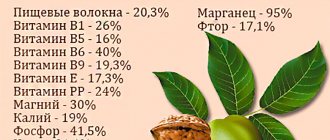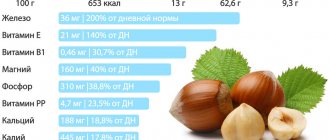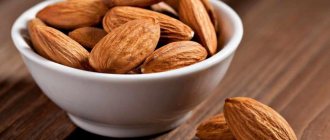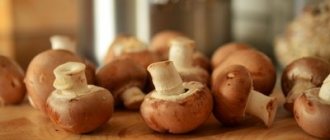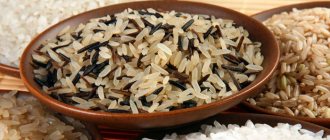Chemical composition and calorie content
The nut kernels include:
- fixed oils;
- protein compounds;
- vitamins: groups A, B, K, vitamin C, nicotinic acid;
- amino acids: asparagine, cysteine, glutamine, serine, histidine, valine;
- macroelements: calcium, potassium, magnesium, phosphorus, sodium, chlorine, sulfur;
- trace elements: iron, zinc, iodine, copper, manganese.
The calorie content of walnuts is 656 kcal/100 g due to the high level of complex carbohydrates.
Did you know? In Ancient Babylon, priests noticed that walnuts resembled the human brain in appearance. It was forbidden for commoners to eat them, as it was believed that this would make them wiser, and this was undesirable.
Allergen f256 - walnut, IgE (ImmunoCAP)
Walnut, as an etiological factor in food allergies, is considered to have a high degree of allergenic activity (without taking into account individual characteristics). It is a common “hidden” allergen - it is often used in the manufacture of confectionery, baked goods, and sauces. Cross-allergy to tree pollen (birch, alder, hazel) is often observed. An allergic reaction to nuts, including walnuts, can often occur in the form of a severe attack of bronchial asthma.
Synonyms Russian
Specific immunoglobulins of class E (IgE) to walnuts.
English synonyms
Allergen f256 - Walnut, IgE.
Research method
Solid phase immunofluorescence (ImmunoCAP).
Units
kUA/l (kilounit of allergen per liter).
What biomaterial can be used for research?
Venous blood.
How to properly prepare for research?
- Do not smoke for 30 minutes before the test.
General information about the study
Walnuts are widely consumed in their natural form, as part of confectionery and many other dishes. Walnut oil is used in cooking and is also added to painting varnishes, soaps, and cosmetics. Walnut wood is a valuable species, harvested in small quantities and used to make high-quality furniture.
The most common are allergic reactions after eating nuts, which can be severe (it is also possible to develop a respiratory allergy to walnut pollen).
According to statistics, 90% of all deaths caused by food allergy attacks are due to nut allergies. Of all other types of food allergies, it is the most persistent - if it manifests itself in several types of nuts at once. There is a good chance that an allergy to one type of nut will go away on its own over time. If an allergy is present to several types of nuts at once (peanuts, walnuts, hazelnuts, cashews and others), there is no such probability at all. Walnuts contain fatty oil, proteins, carbohydrates, provitamin A, vitamins K and P, amino acids (asparagine, cystine, glutamine, serine, histidine, valine, phenylalanine). Fatty oil consists of glycerides of linoleic, oleic, stearic, palmitic and linolenic acids. All of these substances may have strong sensitizing activity. Moreover, under thermal influence (frying, cooking), it can intensify.
Many products contain traces of nuts: chocolate, ice cream, candy, baked goods, yoghurts, quick breakfasts, etc.
A cross-reaction with walnut allergies can occur with apples, soybeans, peaches, asparagus, apricots, plums, olives, cherries, corn, grapes, and upon contact with birch and alder pollen.
Allergy symptoms can appear within 3-5 minutes after contact with the allergen; as a rule, they increase over time and reach a maximum after 1-3 hours. Allergic symptoms include local (burning, itching, tingling sensation and swelling of the tongue, lips, palate and gums, soreness, rashes around the mouth, peeling of the lip red border area, the so-called oral allergic syndrome) and general manifestations. The allergy is accompanied by hives with characteristic redness, burning and itching. Rashes can be of various types; the face, abdomen, and chest are most susceptible to them. A runny nose, sore throat, swelling, shortness of breath, sneezing, coughing, watery eyes, and swollen lips may also occur. People with food allergies often experience gastrointestinal distress. Complex cases may be accompanied by attacks of suffocation, angioedema or anaphylactic shock.
The purpose of this study is to determine specific IgE to the walnut allergen using the ImmunoCAP method. Allergy diagnostics with ImmunoCAP technology is characterized by high accuracy and specificity, which is achieved by detecting even low concentrations of IgE antibodies in a very small amount of the patient’s blood. The study is based on the immunofluorescent method, which makes it possible to increase sensitivity several times compared to other diagnostic methods. Worldwide, up to 80% of determinations of specific IgE immunoglobulins are performed by this method. WHO and the World Allergy Organization recognize diagnosis using ImmunoCAP as the “gold standard”, as this technique has proven its accuracy and consistency in independent studies.
What is the research used for?
- Identification of sensitization to walnuts in children and adults;
- determination of possible causes of exacerbation of an allergic disease (allergic rhinitis/rhinoconjunctivitis, bronchial asthma, atopic dermatitis, urticaria, anaphylactic shock, angioedema, gastrointestinal dysfunction).
When is the study scheduled?
- If patients are suspected of having a walnut allergy;
- when examining patients with polysensitization;
- when examining patients with clinical manifestations of allergic reactions (skin rashes, angioedema, redness and burning in the mouth, swelling of the eyelids, lacrimation, sneezing, congestion, rhinorrhea, cough, shortness of breath, bronchospasm, nausea, vomiting, diarrhea) after eating walnuts;
- if skin testing is not possible.
What do the results mean?
Reference values: 0.00 - 0.35 kU/l.
Reasons for the increased result:
- sensitization to walnuts.
Reasons for negative results:
- lack of sensitization to this allergen;
- long-term restriction or exclusion of contact with the allergen.
Important Notes
- Performing this study is safe for the patient compared to skin tests (in vivo), since it eliminates the patient’s contact with the allergen. Taking antihistamines and age characteristics do not affect the quality and accuracy of the study.
Also recommended
- Total immunoglobulin E (IgE) in serum
- Fadiatope (ImmunoCAP)
- Fadiatope for children (ImmunoCAP)
- Allergen f309 – chickpeas (chickpeas), IgE
- Allergen f202 - cashew nut, IgE
- Allergen f203 - pistachio nuts, IgE
+ determination of specific immunoglobulins class E for other allergens
Who orders the study?
Allergist, gastroenterologist, dermatologist, pediatrician, therapist, general practitioner.
Literature
- Pediatric Allergy: Principles and Practice, 18, 167-176.
- Henry's Clinical Diagnosis and Management by Laboratory Methods, Chapter 55, 1057-1070.
- Nelson Textbook of Pediatrics, Chapter 146, 1121-1124.
- Pollen–Food Syndrome. Antonella Muraro and Cristiana Alonzi. Food Allergy, Chapter 7, 83-98.
- www.phadia.com. ImmunoCAP-Allergens.
Useful properties and contraindications
Daily consumption of nuts has a beneficial effect on the performance of the brain, heart, liver and gastrointestinal tract, helps with body diseases, fights hormonal imbalances in women and increases potency in men.
- Beneficial features:
- activates brain activity. Magnesium and Omega-3 are necessary for mental stress, and for memory development, a child needs fatty acids;
- improves metabolism and functioning of the gastrointestinal tract. Thanks to fiber, metabolism is stabilized. Improves metabolism and reduces the risk of obesity;
- blocks the likelihood of developing type 2 diabetes mellitus and anemia. Vitamin E and Omega-3 prevent diabetes and reduce blood cholesterol levels. Iron corrects hemoglobin levels and reduces the risk of anemia;
- strengthens the skeleton. Children need calcium for the proper formation of bones and teeth; consuming the daily amount reduces the risk of rickets;
- prevention of prostatitis and adenoma in men. The level of zinc in the blood regulates testosterone levels and prostate function;
- reduces the risk of breast cancer in women. It also normalizes the menstrual cycle and has an analgesic effect during menstruation;
- minimizes the likelihood of damage to the central nervous system in the fetus due to the high content of folic acid.
- Contraindications for use:
- obesity of the 2nd–4th degree (due to the high calorie content of the product);
- allergic reactions are possible to any component of the nut;
- increased blood clotting. Protein and calcium form fibrin, which leads to thrombosis;
- pancreatitis and gastrointestinal diseases;
- skin diseases (components contained in nuts increase itching and provoke new rashes).
How to buy and store walnuts
Today, already shelled nuts are often sold, but it is better to buy them in shells, since air dries out the fruits and light destroys some beneficial substances. In addition, kernels without shells can suffer from fungus, and their shelf life is very short.
If you purchase nuts in shell, it is better to put them in a bag made of natural fabric and store them in the refrigerator or other dark, cool place (up to +15 ° C). In such conditions, the fruits can be kept for up to 2 years, although it is better to eat them earlier.
Walnut for weight loss
When losing weight, the body is susceptible to stress, so daily consumption of nuts is useful to normalize the nervous system and correct clarity of thoughts.
Important! With regular consumption of nuts during weight loss, the functioning of the heart and the condition of blood vessels are normalized, thus improving the cleansing of the body's cells.
With the correct dosage, the body's metabolic processes are activated, and losing weight becomes easier. Due to fiber, a feeling of fullness quickly comes, and the feeling of hunger does not return for a long time.
Is it possible to get better from walnuts?
Despite the high fat content in the kernels, they cannot make you fat if you follow the rules. Since the composition includes polyunsaturated fatty acids, these are healthy and proper fats, they are completely broken down in the body and are not stored in fat reserves. However, if you overeat the daily norm or consume them after 17:00, you may gradually gain weight.
Is it possible to eat walnuts at night?
You can eat them at night if you really want to, but it’s better to postpone the treat until the morning. Walnuts are quite high in calories and you should not eat such food before bed, there is a risk of gaining weight. But this would be an ideal option for a daytime energy snack: it gives a boost of energy and improves mental abilities.
Important! The maximum benefit of walnuts is possible by thoroughly chewing the kernels.
Daily value of walnuts
If there are no contraindications for eating, then the optimal number of kernels per day is 8–10 pieces. When actively losing weight, it is advisable to reduce consumption to 5 pieces per snack so as not to gain weight. Men who are actively involved in physical activity are shown up to 15 cores. It is advisable for pregnant women to eat up to 10 nuts per day. Preschool children are allowed to eat 2–4 kernels, and schoolchildren can eat up to 5 pieces.
Is it possible to get better from nuts?
Nuts have high nutritional value. The calorie content of different types of fruits varies from 570 to 700 kC. Until 2008, nutritionists were divided into two camps. Some believed that the high nutritional value of nuts made them fat, while others denied the effect of fruits on weight gain.
In 2008, a number of studies and experiments were carried out. According to a number of sources, nuts should be left in the diet of people who want to lose weight. Consumption must obey a number of rules. You can gain weight and get fat from any product if you eat it uncontrollably. The answer to the question of whether nuts make you fat can be answered yes, if you do not follow the rules of consumption:
- consumption rate - 20 grams per day will be beneficial and will not harm the figure. This amount is approximately 150 kC. This is the average. In some cases, you can eat up to 100 grams. They will be discussed below;
- time – you need to eat nuts up to 14 hours a day. Use as a snack or for breakfast. Losing weight is subject to one important rule - calorie deficit. If you eat a treat in the afternoon, weight gain is guaranteed;
- use a “clean” product. Nuts coated with caramel, chocolate, coconut or salted nuts will not bring any benefits, but they will help you gain weight.
Based on these three rules, you can eat nuts with pleasure without fear of excess weight. The fruits are well nourishing, so they eliminate the risk of overeating.
Use in cooking
Walnuts are widely used in cooking due to their unusual taste and nutritional value. They are added to meat dishes, for example, Georgian satsivi, soups and salads. They occupy a special place in oriental cuisine; they are used to prepare sweets such as Turkish delight, baklava, etc.
Did you know? The average lifespan of a walnut tree is 200 years, but in nature there are also long-livers that are 300–400 years old.
They are used for salad dressings, marinades are prepared with them, added to mustard and yoghurts, and served with meat and fish. They also make alcoholic and non-alcoholic drinks, such as cognac, liqueur, compotes and jelly. Oil is obtained from them, and jam is prepared from unripe nuts.
Walnuts are an indispensable product in the human diet. They are a source of energy, essential amino acids and fats that are not produced independently in the body, but are very useful. Nuts have unique properties and have virtually no contraindications; their main feature is that they can be used in diets for weight loss.
How is fructose different from regular sugar?
The source of white sugar is sugar beets or sugar cane (the only difference is in the region of cultivation). Before being turned into a sweetener, these plants go through several stages of processing. First of all, the root vegetables are crushed to the state of chips, and then the juice is extracted from them using hot water and special equipment. By the way, at this stage the “sweet liquid” of root vegetables contains about 15% sucrose. Subsequently, this juice is sent for filtration, after which syrup is prepared from it, then evaporated under the influence of sulfur dioxide and, finally, filtered again. At the current stage, the sucrose level rises to 60%. A mandatory step in the production of sugar is the crystallization process, where sucrose is separated from the other components of the mixture, and the output is simple white sugar. The bulk of its composition consists of carbohydrates (97%), vitamin B2 and 3 microelements - calcium, iron and potassium.
Due to deep processing, sugar turns out to be a very powerful sweetener, which today is used literally everywhere: in desserts, soups, meat or canned food.
Meanwhile, this product poses a direct danger to people suffering from excess weight, as well as diabetes. If in the first case a person gains extra pounds (one way or another this is a fixable matter), then in the second case the person’s life itself is at stake. The fact is that sucrose instantly raises blood sugar levels, sharply worsening the body’s well-being. In contrast, fructose does not change these indicators and is easily absorbed, including mild digestion in the stomach. Find out the causes of excess weight and ways to quickly lose weight
Sign up for a free initial appointment with a nutritionist!
Let us remember that regular sugar contains practically no vitamins, while “fruit sugar” is rich in vitamin and mineral complexes, and most importantly, fruits contain a lot of fiber, which is indispensable for successful weight loss. It is this component that allows you to quickly get enough and eliminates the feeling of hunger for a long time. It’s not for nothing that at night it is recommended to eat a fruit (or vegetable) high in fiber - you get a minimum of calories, but at the same time you don’t starve yourself.
Are there dietary nuts?
An analysis of KBZHU will help you estimate how many nuts and which ones you can eat while losing weight. Obviously, there are no dietary nuts that can be consumed without restrictions on quantity.
Most of the nuts that are sold in stores in ready-made form can also hardly be called dietary.
When on a diet, it is better to avoid fried, salted, and also those prepared with a large amount of spices. Only raw nuts will be considered dietary, since they retain the greatest amount of nutrients and do not create unnecessary stress on the kidneys and heart, and do not increase appetite.
Contraindications
Hazelnuts are undoubtedly a useful product, but you should not abuse them, otherwise you can cause a backlash. The nut is high in calories; 100 g contains approximately 670 kcal. Regularly exceeding the daily norm is fraught with significant weight gain. Obesity may develop.
It is also known that nuts are an allergen. With its uncontrolled use, a release of histamine into the blood is possible, which will lead to the development of such reactions as:
- swelling of the mucous membranes;
- allergic rhinitis;
- cough;
- rash, redness;
- hives;
- nausea, vomiting;
- anaphylactic shock.
There are a number of contraindications for which eating nuts is strictly prohibited. This includes:
- skin diseases;
- worsened diseases of the gastrointestinal tract;
- poor blood clotting;
- obesity.
In other cases, hazelnut consumption should be limited to 30-50 g. The daily norm for a child should be only 2-3 nuts. This amount is enough to provide the child's body with the necessary nutrients.
Hazelnuts are a very hard product and before giving them to your child to eat, they should be crushed in any convenient way.
Benefits of hazelnuts
Hazelnut
Hazelnut contains about 58-71% fat, 14-18% highly digestible proteins, 2-5% sugar, vitamins A, B, E, K and others, microelements: potassium, calcium, sodium, magnesium, manganese, copper, iron, sulfur, phosphorus, choline, etc.
Benefits of hazelnuts
This nut is recommended for restoring strength. It supplies the body with missing vitamins and microelements, and participates in strengthening the walls of blood vessels and the heart muscle. Regular consumption of nuts will prevent the formation of cholesterol plaques, the development of varicose veins and thrombophlebitis.
Hazelnuts have a beneficial effect on the walls of blood vessels, strengthening them and making them elastic. Hazelnut kernels strengthen the immune system. The nut provides invaluable help to the liver: it cleanses it of decay products and prevents the accumulation of toxic substances.
Hazelnuts calm the central nervous system, relieve nervous tension, eliminate anxiety, prevent insomnia. They are essential for men's health - nuts increase the production of sex hormones and libido levels. Hazelnuts are used in the prevention of prostate diseases. Eating nuts gives strength, relieves inflammation, and normalizes sexual function.
The effect of hazelnuts on the human body:
- Vitamin A improves vision and improves immunity.
- The B complex of vitamins normalizes the functioning of the central nervous system, improves blood composition, strengthens the immune and circulatory systems, and the metabolic system.
- Folic acid (vitamin B9) takes part in metabolism, helps improve immunity, and normalizes the function of the digestive tract. For pregnant women, it is necessary for normal growth and development of the fetus.
- Vitamin E is a powerful antioxidant that reduces the risk of various diseases. It is responsible for the state of reproductive function, fights free radicals and prevents early cell aging.
- Vitamins K, potassium, calcium , etc. improve the condition of the skin, bones, joints, nails and teeth.
- Potassium is effective in preventing cardiovascular diseases.
- Calcium regulates intracellular processes - muscle contraction, secretion of hormones and neurotransmitters.
- A large amount of potassium and magnesium ensures the normal functioning of the heart muscle, normalizes blood pressure, helps to timely control the water-salt balance, preventing edema and increases the body's resistance to various diseases.
- Copper affects enzymes, protein metabolism, and bone growth.
- Magnesium is necessary to maintain normal function of the nervous system and heart muscles, has a vasodilating effect, stimulates bile secretion, increases intestinal motor activity, which helps remove cholesterol from the body . It is a cofactor in many enzymatic reactions. Magnesium is a universal supplier of energy in living cells of the body.
- Cobalt is involved in hematopoiesis, functions of the nervous system and liver, and enzymatic reactions.
- Retinol has a positive effect on the condition of nails, hair, and epidermis.
- Sulfur is part of the protein collagen and protein keratin, which gives hair, nails and skin strength, shape and elasticity. Participates in the formation of bone and cartilage tissue, improves the functioning of joints and ligaments; strengthens muscle tissue; has a wound healing and anti-inflammatory effect; helps neutralize and flush out waste and toxins from the body; affects blood clotting; participates in the secretion of bile by the liver; increases resistance to radio radiation. Improves the functioning of the nervous system; stabilizes blood glucose levels; increases immunity; has an antiallergic effect.
- Phosphorus - helps strengthen the musculoskeletal system, is an energy accumulator.
- Choline is necessary for the treatment of liver diseases and atherosclerosis.
